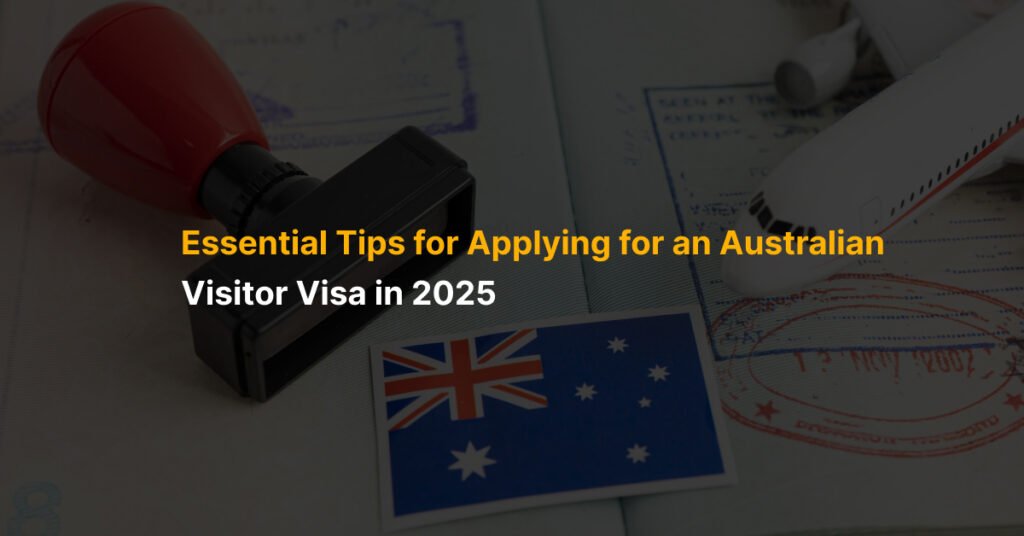Essential Tips for Applying for an Australian Visitor Visa in 2025

Australia is a top destination for tourists, medical travelers, and business visitors alike. To enter the country, most international travelers need a visitor visa, such as the eVisitor, ETA, or Tourist Visa. Whether you’re planning a short vacation, visiting family, or seeking medical treatment, understanding the requirements and process for a visitor visa is crucial. For those needing expert guidance, migration agents in Melbourne, like CG Migration Services, can provide invaluable assistance. Types of Visitor Visas for Australia Choosing the right visa type is the first step. Here’s a breakdown of the most common visitor visas available: 1. Australian Tourist Visa (Subclass 600) For those visiting Australia for tourism or family purposes, this visa is ideal. It allows you to experience Australia’s cultural and natural attractions. 2. Electronic Travel Authority (ETA) Visa (Subclass 601) This online visa is available to citizens of select countries, offering a quick and paperless application process. 3. eVisitor Visa (Subclass 651) Similar to the ETA, this visa caters to European nationals and allows electronic submission of applications. 4. Medical Treatment Visa (Subclass 602) Designed for individuals seeking medical treatment in Australia, this visa also extends to those supporting patients or donating organs. Documents Required for an Australian Visitor Visa Each visa type has specific documentation requirements, but the essentials include: Tourist Visa (Subclass 600) Valid Passport Proof of sufficient funds Invitation letter (if applicable) Health and character evidence Proof of intent to leave Australia after the visa expires Electronic Travel Authority (Subclass 601) Valid Passport Identification documents Credit or debit card for payment Additional documents if further processing is required Medical Treatment Visa (Subclass 602) Identity documents Health and character certificates Proof of financial stability to cover medical expenses Evidence of intent to leave Australia post-treatment eVisitor Visa (Subclass 651) Valid Passport Flight itinerary Proof of a temporary trip Bank statements for the past three months Reason for visiting Australia Key Points to Remember Choose the Correct Visa Type: Select a visa that aligns with your purpose of travel, whether it’s tourism, business, or medical treatment. Complete Documentation: Ensure all documents are accurate and up-to-date. Missing or incorrect details can delay or even lead to visa rejection. Financial Proof: Provide evidence of sufficient funds to cover your stay, including accommodation, transport, and daily expenses. Clear Intentions: Demonstrate your intent to return to your home country by providing return flight bookings or evidence of ties to your home country. Seek Expert Guidance: Consulting with a migration agent ensures your application is accurate and complete, reducing the chances of rejection. Benefits of Consulting a Migration Agent in Melbourne Migration agents bring expertise and peace of mind to your visa application process. Here’s how they can help: Assess your eligibility and recommend the right visa type. Ensure your application is complete and error-free. Provide tailored advice based on your specific circumstances. Handle any queries or additional requirements from the Department of Home Affairs. At CG Migration Services, our Melbourne-based team specializes in helping clients navigate the complexities of Australian visitor visas. Applying for an Australian Visitor Visa doesn’t have to be overwhelming. With proper preparation and guidance, you can ensure a smooth and successful application process. If you’re in Melbourne and need professional assistance, reach out to CG Migration Services. Our experienced migration agents are ready to help you every step of the way. Start your journey to Australia today with confidence and ease!
5 Proven Tips for a Successful Partner Visa Australia Application in 2025

1. Choose the Correct Visa Type Selecting the appropriate visa type is the foundation of a successful application. There are two main options: Offshore Partner Visa: Ideal for couples where one partner is outside Australia. Once granted, the visa allows entry and permanent residency in Australia. Onshore Partner Visa: Suitable for applicants already residing in Australia. You can remain in the country on a bridging visa while your application is processed. Understanding your eligibility and selecting the right visa type ensures a smoother process. 2. Understand Requirements and Eligibility A thorough understanding of the application requirements is essential. Key aspects include: Demonstrating a genuine relationship through evidence of cohabitation, shared finances, and social acknowledgment as a couple. Providing proof of being in a committed relationship for at least 12 months (if not married). Submitting accurate and complete details about your relationship, including joint living arrangements and shared responsibilities. Inadequate evidence or incomplete details are common reasons for rejection, so meticulous preparation is crucial. 3. Prepare Verified Documents Your application’s success heavily relies on the documentation provided. Key documents include: Passport copies (including dependents, if applicable). Marriage or relationship certificates. Joint lease agreements or utility bills in both names. Bank statements showing joint accounts. Photos that reflect your relationship milestones. Statutory declarations from friends and family confirming your relationship. Ensure every document is accurate, up-to-date, and supports your case for a genuine relationship. 4. Seek Professional Guidance from a Migration Agent A registered migration agent can provide invaluable assistance by: Reviewing your application for completeness and accuracy. Advising on specific documentation needed for your unique circumstances. Handling communication with the Department of Home Affairs on your behalf. At CG Migration Services, our Melbourne-based migration experts specialize in Partner Visas, offering tailored advice to increase your chances of approval. 5. Provide Honest and Accurate Information Honesty is critical when submitting your application. Avoid common pitfalls such as: Providing false or misleading documents. Omitting important details about your relationship or dependents. Failing to meet the character or health criteria. Submitting accurate and truthful information builds trust and reduces the likelihood of delays or rejection. Partner Visa Processing Times & Success Rates Processing Time: Permanent Partner Visa processing typically begins two years after the initial application. Success Rates: Historically, success rates hovered around 50%, but recent trends show a decline, emphasizing the need for thorough preparation and professional assistance. Applying for a Partner Visa in Australia can be daunting, but with the right preparation and guidance, you can significantly increase your chances of success. Follow these five tips to streamline the process, avoid common pitfalls, and confidently reunite with your partner in Australia. For personalized advice and assistance, reach out to CG Migration Services in Melbourne. Our expert team is ready to guide you every step of the way, ensuring a stress-free application experience. Book a consultation today!
